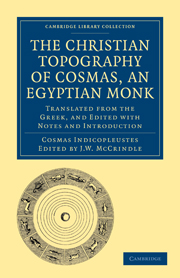 The Christian Topography of Cosmas, an Egyptian Monk
The Christian Topography of Cosmas, an Egyptian Monk INTRODUCTION
Published online by Cambridge University Press: 10 November 2010
Summary
TheChristian Topography of Cosmas, surnamed Indicopleustes, or the Indian Navigator, has been preserved in two copies: one a parchment MS. of the tenth century belonging to the Laurentian library in Florence, and containing the whole work except only the last leaf; the other, a very fine uncial MS. of the eighth or ninth century, belonging to the Vatican library, and containing sketches drawn by Cosmas himself, but wanting entirely the twelfth book, which is the last. There is, besides, in the Imperial library in Vienna, a Cosmas MS., but this contains only a few leaves of the Topography.
The existence of the work, which had been for ages forgotten, and the importance and interest of its contents, were first made known in the latter half of the seventeenth century by Emeric Bigot. This learned French scholar, while visiting Italy, extracted from the Florentine Codex a copy of the Adulitic Inscriptions, and of passages relating to Ethiopia and India. These extracts were afterwards published in Thevenot's Relation de divers Voyages, accompanied with a translation into French. Twenty years later (1706), the work appeared in its complete form as exhibited in the Florentine Codex, collated with that of the Vatican. It was not, however, published separately, but was included in the second volume of the splendid work Nova Collectio Patrum et Scriptorum Graecoruni, edited by Father Montfaucon, a Benedictine monk, celebrated for his profound knowledge of Patristic literature.
- Type
- Chapter
- Information
- The Christian Topography of Cosmas, an Egyptian MonkTranslated from the Greek, and Edited with Notes and Introduction, pp. xiii - xxviiiPublisher: Cambridge University PressPrint publication year: 2010First published in: 1897


